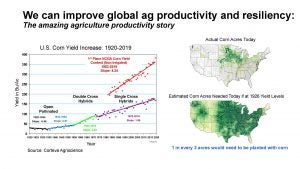Corteva Agriscience Global Plant Breeding Leader Geoff Graham told attendees of the 2020 USDA Ag Outlook Forum that advanced plant breeding techniques and proven success in improving crop productivity in developed regions provides a road map to managing risk from food insecurity and climate volatility around the world.
The USDA Forum is focused on Innovation in Agriculture and earlier U.S. Secretary of Agriculture Sonny Perdue announced the Agriculture Innovation Agenda. Graham’s remarks were made as part of a session track on managing risk and ensuring sustainability in production agriculture.
“Not only is agricultural productivity critical to meeting the demands of a growing population, it’s also a critical tool to combat climate volatility,” said Graham. “We have proven that innovative breeding technologies such as molecular markers, precision phenotyping, predictive analytics, biotechnology, CRISPR, and digital tools can help agriculture better manage the challenges of extreme weather.”
USDA Risk Management Agency Administrator Martin Barbre chaired the “Mitigating Production Risk” panel discussion during the Forum, which centered on the challenges that farmers and government decision makers face during growing seasons with extreme weather conditions. He noted that 2019 was one of the wettest farming years on record, while 2012 was one of the driest. Despite increased weather variability, overall crop yields continue to trend upward over time.
Graham said the almost seven-fold increase in average corn yields achieved in North America since 1920 means we’ve grown millions of additional bushels of grain without putting a corresponding number of acres into agricultural production. Yield improvements over the last century have increased productivity from an average of 25 bushels per acre to 170 bushels per acre. Further, he said if the top 20 world corn-producing countries improved their production levels to those found in the U.S. 20 years ago, it would be the equivalent of adding another 100 million acres of farmland.

“We’re producing more outputs with fewer inputs,” explained Graham. “But food insecurity and climate volatility do not impact the globe uniformly and we must also work to develop new cropping systems adapted to local conditions.”
“This will take all the tools in our toolbox, as well as open and transparent communication between the public, academia, governments, and private companies,” Graham stated. “Independently, these technologies are just tools — but, collaboratively, they are solutions to some of the world’s greatest challenges.”
The panel also included remarks from former Illinois State Climatologist Jim Angel and USDA-National Agricultural Statistics Service Crops Branch Chief Lance Honig. Materials from the session are made available on the USDA website.


